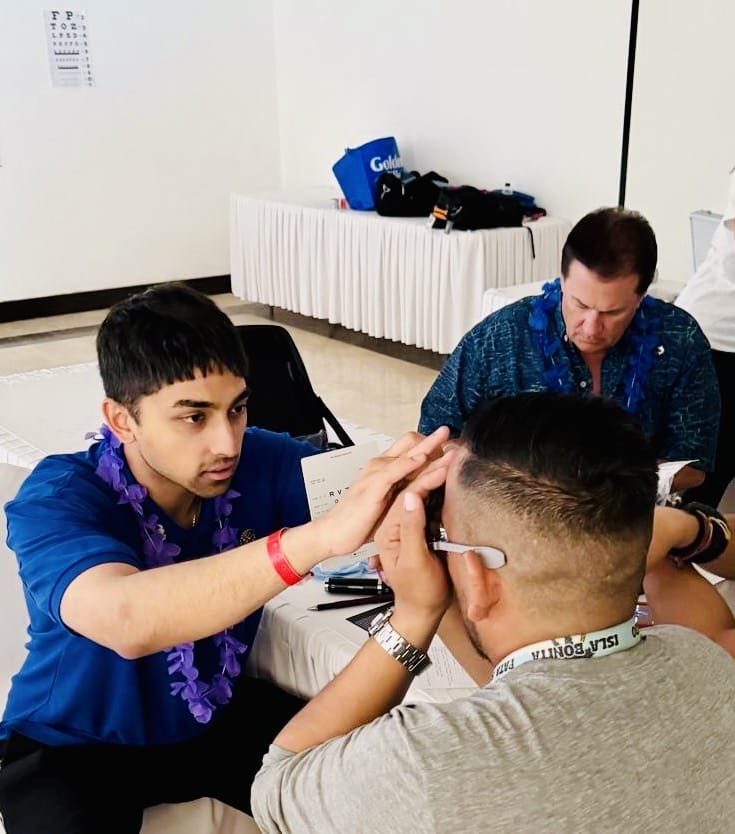WesternU joins NIH in promoting Glaucoma Awareness Month
Glaucoma is a major cause of vision loss in the U.S., but it is also a silent disease that can only be detected in its early stages by an eye examination.
Western University of Health Sciences is joining the National Eye Institute in promoting Glaucoma Awareness Month in January. WesternU encourages people to visit its Eye Care Center, 795 E. Second St., Pomona, Calif. 91766, for a comprehensive eye exam.
Treatment for glaucoma is much more effective with early detection rather than as the disease condition progresses, said Robert Gordon, OD, FAAO, DPNAP, WesternU College of Optometry Associate Dean of Clinical Affairs. The Eye Care Center is fully equipped to evaluate and treat numerous types of glaucoma.
It’s important for people to have their eyes examined on a regular basis because there are no symptoms of glaucoma that would alert them that a problem exists, said Linda Pang, OD, College of Optometry Coordinator of Low Vision Services.
“In its early stages, glaucoma is a condition that is only picked up during an eye examination,” she said. “We check their eye pressure and the structures in the back of the eye to assist in determining if there is a risk to the patient of losing sight from glaucoma.”
For more information or to make an appointment, call the Eye Care Center at 909-706-3899 or visit the website http://www.westernupcc.com/eye.html.
The National Eye Institute (NEI), a part of the National Institutes of Health, observes Glaucoma Awareness Month each January by encouraging Americans at higher risk for glaucoma to schedule a comprehensive dilated eye exam and to make a habit of doing so every one to two years. While anyone can get glaucoma, people at higher risk include African Americans age 40 and over; adults over the age of 60, especially those who are Mexican American; and people who have a family history of the disease.
Glaucoma is a major cause of vision loss in the United States and it is becoming more prevalent as our population ages. About 2.7 million Americans 40 and older have primary open-angle glaucoma, the most common form, and this number is expected to grow, according to NIH.
“Vision Problems in the U.S.,” a report released in 2012 by Prevent Blindness America and NEI, predicts that by 2030 the disease will affect 4.2 million Americans.
Glaucoma can be detected in its early stages through a comprehensive dilated eye exam before vision loss occurs. During this exam, drops are placed in the eyes to dilate, or widen, the pupils. This allows an eye care professional to examine the optic nerve for signs of damage and other possible problems. An eye pressure test alone is not enough to detect glaucoma. People in the higher risk categories should not wait until they notice a problem with their vision to have an eye exam. Primary open-angle glaucoma often has no symptoms in its early stages, so people may not know they have glaucoma until they start to have noticeable vision loss.
It is unnecessary for glaucoma to cause vision loss in the modern world, said Bennett McAllister, OD, FAAO, College of Optometry Chief of Primary Care Optometry and Acting Chief of Low Vision.
“The biggest problem we have is patients not getting checked for it,” he said. “People think if it doesn’t hurt or if they see fine, then they’re OK. That’s not true. Glaucoma is insidious. It robs you without you knowing it.”
As part of its National Eye Health Education Program (NEHEP), NEI develops a variety of education materials in English and Spanish describing the leading causes of blindness, including glaucoma, diabetic eye disease, age-related macular degeneration, and cataracts. To learn more about glaucoma, how to keep your eyes healthy, tips for talking with your eye care professional, the benefits of getting a comprehensive dilated eye exam, and where to get financial assistance for eye care, visit http://www.nei.nih.gov/glaucoma.
The NEHEP also develops materials for health educators and community organizations to conduct educational sessions in their community about glaucoma. New this year is the Keep Vision in Your Future Glaucoma Toolkit. To find educational resources available from NEHEP, visit http://www.nei.nih.gov/nehep/programs/glaucoma.
###
About Western University of Health Sciences
Western University of Health Sciences (www.westernu.edu), located in Pomona, Calif. and Lebanon, Ore., is an independent nonprofit health professions university, conferring degrees in biomedical sciences, dental medicine, health sciences, medical sciences, nursing, optometry, osteopathic medicine, pharmacy, physical therapy, physician assistant studies, podiatric medicine and veterinary medicine. The Chronicle of Higher Education named WesternU a 2012 Great College to Work For.
About the National Eye Institute
The National Eye Institute, part of the National Institutes of Health, leads the federal government’s research on the visual system and eye diseases. NEI supports basic and clinical science programs that result in the development of sight-saving treatments. For more information, visit http://www.nei.nih.gov.
About the National Institutes of Health (NIH): NIH, the nation’s medical research agency, includes 27 Institutes and Centers and is a component of the U.S. Department of Health and Human Services. NIH is the primary federal agency conducting and supporting basic, clinical, and translational medical research, and is investigating the causes, treatments, and cures for both common and rare diseases. For more information about NIH and its programs, visit http://www.nih.gov.
NIH…Turning Discovery Into Health®



